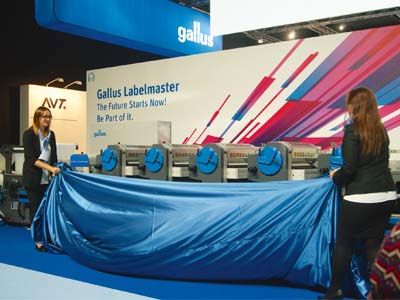The Labelmaster was unveiled to the press and potential customers at the Gallus Innovation Days
Gallus held its Innovation Days open house event to launch the Labelmaster, its first fully conventional press since its shares were bought out entirely by Heidelberg in 2014. By Michal Lodej.
The new Labelmaster is being marketed as a press which can meet the needs of the entire label market. The press has a modular design, so that printers can add printing stations and finishing units, as and when they need them.
Heavily influenced by Heidelberg, the press has been in development since the company bought 100% of Gallus’ shares, and its modular build is hoped to appeal to both entry level and high production label printers.
Stephan Plenz, member of the Heidelberg management board for equipment said, ‘If we develop something which does not keep the customer in mind then it is a waste of time and resources. There are two different ways we can make money for our customers, one is operational excellence. If you are the same as everyone else then you better have higher productivity and a good price level. If you don’t push productivity then someone will take away your business. The second way our customers can make money is to be different, do something your competitors can’t do. This concept is being driven into the products that we make.’
The Labelmaster sees the company back to developing a purely conventional printing press after it launched the Labelfire at Labelexpo Europe 2015, a hybrid press which used an inkjet printing unit to provide inline digital printing capabilities with a flexo press.
Klaus Bachstein, CEO, said ‘Conventional technology is still a huge market and is growing still. There are needs at both ends of the scale and self adhesive label usage is growing 4% per month, by no means is conventional slowing.’
In the new platform system, the press is made up of modules that each comprise of two printing units. These modules are available in three different variants. The basic version already covers all the required standards of the label printing. The Plus version allows greater flexibility and the advanced version is configurable for all needs in the level of automation.
This modularity is made possible by a new locking system positions the printing units on the base and locks them in place, ensuring 100% register accuracy regardless of substrate. The machine system supports a wide range of substrates, from paper and PE to PP and foil.
Christof Naier, head of sales and marketing, added, ‘With continued success of the ECS it showed us that there is a high demand for that price performance ratio. With this new press we wanted to move that ratio onto wider widths and so going to 440 mm opens customers up to this performance level on sleeves and wraps too.’
Mr Bachstein, continued, ‘Its not just a wider version of the 340, it’s a platform that can grow with the customers needs as they do. We wanted the latest technology and to use the vast experience we now have from Heidelberg combined with the price performance ratio from Gallus before.’
To show off the machine’s capabilities the press operators printed three different jobs in less than 10 minutes, running 300 metres of salable labels for each job.
The first job was an engine oil label using CMYK plus a clear varnish, die-cut with matrix removal. They then switched to 25 inch label repeat size, the largest available on the Labelmaster. Flexibility is a major selling point of the press. The third job used a different substrate and used additional ink sets of metallic red and metallic black.
The developers at Gallus have also introduced special feature to make the press user friendly. The press can be controlled centrally via an HMI touch panel, although manual intervention is also supported, with operators able to make changes with. The lightweight aluminium printing cylinders that have been specially developed for this machine type can be changed in just a few quick steps.
However, it is not just setup processes that have been speeded up – the high printing speeds of up to 200 m/min on the press ensure outstanding operational cost-efficiency with absolute register accuracy. A short web path of just 1.1 m from printing unit to printing unit significantly reduces waste and an optimised ink duct for the chambered doctor blade needs just 250 g of ink and therefore keeps costs low. The newly designed flexographic printing unit is driven directly by two servomotors and can also be equipped with a newly developed screen printing unit that enables users to make the most of high-end finishing options.






